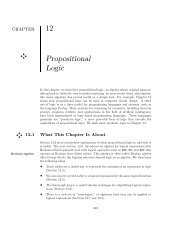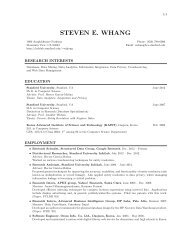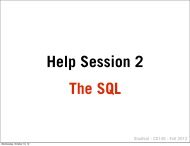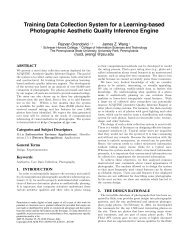SQL Programming - The Stanford University InfoLab
SQL Programming - The Stanford University InfoLab
SQL Programming - The Stanford University InfoLab
You also want an ePaper? Increase the reach of your titles
YUMPU automatically turns print PDFs into web optimized ePapers that Google loves.
Example schema:<br />
CS145 Lecture Notes #10<br />
<strong>SQL</strong> <strong>Programming</strong><br />
CREATE TABLE Student (SID INTEGER PRIMARY KEY,<br />
name CHAR(30),<br />
age INTEGER,<br />
GPA FLOAT);<br />
CREATE TABLE Take (SID INTEGER,<br />
CID CHAR(10),<br />
PRIMARY KEY(SID, CID));<br />
CREATE TABLE Course (CID CHAR(10) PRIMARY KEY,<br />
title VARCHAR(100) UNIQUE);<br />
Motivation<br />
Pros and cons of <strong>SQL</strong>:<br />
Very high-level, possible to optimize<br />
Not tuned to support general-purpose computation<br />
Oracle as a calculator? SELECT 142857*3 FROM DUAL;<br />
Strictly less expressive than general-purpose languages<br />
<strong>SQL</strong>2 has no recursion and cannot even compute factorial!<br />
Solutions:<br />
Augment <strong>SQL</strong>: Oracle’s PL/<strong>SQL</strong><br />
Use <strong>SQL</strong> together with a general-purpose programming language:<br />
embedded <strong>SQL</strong>, dynamic <strong>SQL</strong><br />
Oracle PL/<strong>SQL</strong><br />
Basics<br />
Rough form of a PL/<strong>SQL</strong> program:<br />
DECLARE<br />
BEGIN<br />
END;<br />
.<br />
RUN;<br />
DECLARE section is optional<br />
. and RUN end the program and execute it<br />
Jun Yang 1 CS145 Spring 1999
Example: go through students 142–857 and set all GPA’s under 4.0 to 4.0<br />
DECLARE<br />
thisSID Student.SID%TYPE;<br />
thisGPA Student.GPA%TYPE;<br />
BEGIN<br />
thisSID := 142;<br />
LOOP<br />
EXIT WHEN (thisSID > 857);<br />
SELECT GPA INTO thisGPA<br />
FROM Student<br />
WHERE SID = thisSID;<br />
IF (thisGPA < 4.0) THEN<br />
UPDATE Student SET GPA = 4.0<br />
WHERE SID = thisSID;<br />
END IF;<br />
thisSID := thisSID + 1;<br />
END LOOP;<br />
END;<br />
.<br />
RUN;<br />
Basic features:<br />
Local variable:<br />
Use %TYPE to match its type to a column in the schema<br />
Use := for assignment; = for comparison<br />
Branch: IF (...) THEN ... ELSE ... END IF;<br />
Loop: LOOP ... EXIT WHEN (...); ... END LOOP;<br />
<strong>The</strong> usual data modification statements: INSERT, DELETE, UPDATE<br />
Single-row SELECT: SELECT ... INTO ... FROM ...;<br />
Oracle raises an exception if SELECT returns no rows or more<br />
than one row<br />
Cursors<br />
Inside a PL/<strong>SQL</strong> program, the result of a SELECT must go somewhere:<br />
If SELECT returns one row, it can go INTO a variable<br />
What if SELECT returns multiple rows?<br />
Cursor: a variable that runs through the result of a SELECT, row by row<br />
Declare by: CURSOR IS ;<br />
Use inside a cursor loop:<br />
Fetch one result row at a time: FETCH INTO ;<br />
Break the loop when there are no more rows to return:<br />
EXIT WHEN %NOTFOUND;<br />
OPEN/CLOSE before/after use<br />
Jun Yang 2 CS145 Spring 1999
If cursor is over a single table and has no aggregates or DISTINCT, we can<br />
also modify data through the cursor:<br />
Follow the declaration by FOR UPDATE<br />
Use WHERE CURRENT OF in DELETE or UPDATE<br />
Example: go through all CS145 students and set all GPA’s under 4.0 to 4.0!<br />
Note it is possible to declare a “row” type in Oracle<br />
DECLARE<br />
thisStudent Student%ROWTYPE;<br />
CURSOR CS145Student IS<br />
SELECT * FROM Student WHERE SID IN<br />
(SELECT SID FROM Take WHERE CID = ’CS145’)<br />
FOR UPDATE;<br />
BEGIN<br />
OPEN CS145Student;<br />
LOOP<br />
FETCH CS145Student INTO thisStudent;<br />
EXIT WHEN (CS145Student%NOTFOUND);<br />
IF (thisStudent.GPA < 4.0) THEN<br />
UPDATE Student SET GPA = 4.0<br />
WHERE CURRENT OF CS145Student;<br />
END IF;<br />
END LOOP;<br />
CLOSE CS145Student;<br />
END;<br />
.<br />
RUN;<br />
Stored Procedures<br />
Creating a PL/<strong>SQL</strong> stored procedure:<br />
CREATE PROCEDURE ( ) AS<br />
BEGIN<br />
END;<br />
.<br />
RUN;<br />
<strong>The</strong> RUN above creates the procedure, but does not execute it<br />
Running the procedure inside a PL/<strong>SQL</strong> program:<br />
BEGIN<br />
...<br />
END;<br />
.<br />
RUN;<br />
...<br />
( );<br />
Jun Yang 3 CS145 Spring 1999
Dropping the procedure:<br />
DROP PROCEDURE ;<br />
Example: a procedure to enroll students in CS145<br />
CREATE PROCEDURE<br />
CS145Enroll (thisSID IN Take.SID%TYPE) AS<br />
BEGIN<br />
INSERT INTO Take VALUES(thisSID, ’CS145’);<br />
END;<br />
.<br />
RUN;<br />
Example: students 142 and 857 enroll in CS145<br />
BEGIN<br />
CS145Enroll(142);<br />
CS145Enroll(857);<br />
END;<br />
.<br />
RUN;<br />
Embedded <strong>SQL</strong><br />
Instead of making <strong>SQL</strong> do more, embed it into a general-purpose programming<br />
language (C in our examples):<br />
(1) Host program with special <strong>SQL</strong> directives and commands<br />
Goes through a special DBMS preprocessor to produce:<br />
(2) Host program with special DBMS function calls<br />
Gets compiled and linked with special DBMS library to produce:<br />
(3) Executable code that communicates with the DBMS<br />
Main issues in embedding <strong>SQL</strong> within a program:<br />
Which statements are <strong>SQL</strong>?<br />
Those introduced with EXEC <strong>SQL</strong><br />
How are values passed from the program into <strong>SQL</strong> commands?<br />
Shared Variables: variables that are accessible to both <strong>SQL</strong> and<br />
the host language<br />
In C, variables are used normally<br />
In <strong>SQL</strong>, they must be preceded by a colon<br />
How are results of <strong>SQL</strong> queries returned into program variables?<br />
If query returns a single row, use SELECT INTO<br />
If query returns many rows, use a cursor<br />
Similar to PL/<strong>SQL</strong> cursors, with minor syntactic differences<br />
In Oracle, WHENEVER can be used to break cursor loops<br />
Jun Yang 4 CS145 Spring 1999
Example: go through all CS145 students and change all GPA’s<br />
EXEC <strong>SQL</strong> BEGIN DECLARE SECTION;<br />
int thisSID;<br />
float thisGPA;<br />
EXEC <strong>SQL</strong> END DECLARE SECTION;<br />
EXEC <strong>SQL</strong> DECLARE CS145Student CURSOR FOR<br />
SELECT SID, GPA FROM Student WHERE SID IN<br />
(SELECT SID FROM Take WHERE CID = ’CS145’)<br />
FOR UPDATE;<br />
EXEC <strong>SQL</strong> OPEN CS145Student;<br />
EXEC <strong>SQL</strong> WHENEVER NOT FOUND DO break;<br />
while (1) {<br />
EXEC <strong>SQL</strong> FETCH CS145Student INTO :thisSID, :thisGPA;<br />
printf("SID %d current GPA %f\n", thisSID, thisGPA);<br />
printf("Enter new GPA: ");<br />
scanf("%f", &thisGPA);<br />
EXEC <strong>SQL</strong> UPDATE Student SET GPA = :thisGPA<br />
WHERE CURRENT OF CS145Student;<br />
}<br />
EXEC <strong>SQL</strong> CLOSE CS145Student;<br />
Dynamic <strong>SQL</strong><br />
Embedded <strong>SQL</strong> is fine for fixed applications (e.g., a program used by<br />
the registrar to enroll students in classes)<br />
But we cannot use it to write a program like sqlplus, because we<br />
do not know in advance what <strong>SQL</strong> statements the user will enter<br />
Two special statements in embedded <strong>SQL</strong> which make it dynamic:<br />
PREPARE<br />
EXECUTE<br />
Example: let’s write our own sqlplus!<br />
EXEC <strong>SQL</strong> BEGIN DECLARE SECTION;<br />
char query[MAX_QUERY_LENGTH];<br />
EXEC <strong>SQL</strong> END DECLARE SECTION;<br />
while (1) {<br />
/* issue <strong>SQL</strong>> prompt */<br />
/* read user input into query */<br />
EXEC <strong>SQL</strong> PREPARE q FROM :query;<br />
EXEC <strong>SQL</strong> EXECUTE q;<br />
}<br />
Jun Yang 5 CS145 Spring 1999








